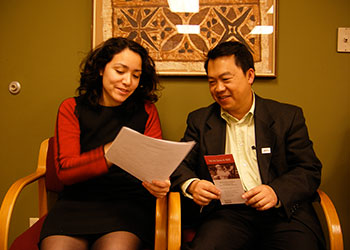News > Fact Sheets
New Rules for Asylum Applicants filing for an EAD: Frequently Asked Questions
Posted on Aug 04 2020
Current as of July 28, 2020
There are two new rules going into effect. Both rules modify the Department of Homeland Security’s (DHS) regulations governing asylum applications, interviews, and eligibility for employment authorization based on a pending asylum application.
Rule 2: Asylum Application, Interview, and Employment Authorization for Applicants
When do these rules go into effect?
Unless stopped by litigation, the “Removal of 30-Day Processing Provision” rule will go into effect on August 21, 2020. The “Asylum Application, Interview, and Employment Authorization” rule will go into effect on August 25, 2020.
What do these rules do?
Removal of 30-Day Processing Provision for Asylum Applicant-Related Form I-765 Employment Authorization Applications
- Removes a rule stating that United States Citizenship and Immigration Services (USCIS) must process an initial employment authorization application within 30 days of the initial filing of Form I-765, Application for Employment Authorization Documents (EAD)
- Asylum seekers who file their work authorization applications on or after August 21, 2020 will no longer be guaranteed that USCIS will process their application within any specified timeframe.
- Removes the requirement that a renewal application must be received by USCIS 90 days before the previous employment authorization expires.
Asylum Application, Interview, and Employment Authorization for Applicants
- Extends the waiting period to apply for employment authorization to 365 days after an asylum application is received by USCIS or the Immigration Court;
- Stops USCIS from issuing ‘recommended approvals’ for asylum;
- Excludes asylum seekers convicted of an aggravated felony and those who “have committed certain lesser criminal offenses on or after the effective date” of August 25, 2020 from receiving employment authorization;
- These lesser criminal offenses will include being convicted of a felony in the United States or a serious non-political crime outside the United States, or being convicted in the United States of certain public safety offenses involving domestic violence or assault; child abuse or neglect; possession or distribution of controlled substances, or DUI;
- Excludes asylum seekers who entered the United States without documentation from applying for an EAD, with some exceptions.
- Revises the provisions for EAD termination so that if an asylum application is denied, any employment authorization associated with a pending asylum application would be terminated as well;
- If, however, it is referred to an immigration judge the EAD will be extended until the judge makes a decision. If that decision is successfully appealed, the EAD will be extended again. An EAD cannot be granted while the case is in Federal court, however, or after the Board of Immigration Appeals (BIA) denies an asylum claim.
- Changes the timeline for filing an asylum application and removes the requirement that USCIS has to return an incomplete application within 30 days;
- This also allows USCIS to deny EAD applications if a delay caused by the applicant is still ongoing when the EAD application is filed. If an applicant misses the asylum interview or a biometrics appointment, the new rule allows for the denial of an EAD.
- Allows USCIS to set EAD validity periods at their discretion and clarifies that any EAD validity period cannot exceed increments of 2 years;
- Incorporates biometrics collection requirements into the employment authorization process for asylum seekers. This requires applicants to appear at an Application Support Center (ASC) for biometrics collection and, if required, pay a separate biometric services fee;
- Makes asylum seekers who file their asylum applications more than 1 year after their arrival into the United States ineligible for an EAD.
How did this part of the law work before these new changes?
Currently, asylum seekers must wait 150 days after submitting their asylum application before filing an EAD application. The government then has 30 days to process the application.
Who is impacted by these rules?
These rules affect anyone applying for asylum who also intends to apply for employment authorization.
In particular, as of August 25, 2020, the following groups are affected:
- Asylum seekers whose asylum applications have been pending for less than 1 year or asylum seekers who were planning on receiving an EAD in less than 1 year;
- This includes those entering at the border, including women and children seeking international protection at a U.S. border or port of entry;
- May include those who are unable to file their asylum application within one year due to administrative or procedural hurdles outside of their own control;
- Asylum seekers applying for an EAD who have committed criminal offenses;
- EAD applicants who change or amend their asylum applications – as this rule might mean that action will impact their chance of getting an EAD.
I am applying for an EAD, but I am not seeking asylum. Do these rules apply to me?
These rules only apply to people who have asylum in the United States or who are applying for asylum in the United States. They do not apply to other non-citizens applying for an EAD.
I am waiting for the asylum office’s decision on my asylum case. Do these rules apply to me?
It depends on if you have already applied for an EAD or if you were planning on doing so in the future.
The rule only impacts EAD applications received after August 25, 2020. If you have already applied, your application will be evaluated the same way EAD’s have been in the past. If you have not yet applied, the rule could apply to future EAD applications.
If you are waiting for a decision on your asylum case and plan to submit an EAD application after August 25, 2020 these new rules will apply to your case.
I am in removal proceedings and waiting for a judge’s decision on my case. Do these rules apply to me?
Yes. If you are applying for asylum and an EAD while in removal proceedings these rules may also apply to you.
I entered the United States without documentation or have committed criminal offenses in the past. Should I be worried that I am no longer eligible for an EAD?
No. If you entered without documentation or committed criminal offenses before August 25, 2020 your eligibility for an EAD should not be different. Going forward, however, committing these actions will make you ineligible.
My current EAD does not expire until after August 25, 2020. Do these rules apply to me?
These rules should not affect your current EAD. If you plan on renewing your EAD after August 25, 2020, your application will be affected.
What should I do if I was planning to apply for an EAD? I’m not sure if these rules apply to me. Who can I call for more information?
Make a note of the August start dates of these rules and consult with an immigration attorney as soon as possible to discuss how the rule could impact you.
If you have questions about these new rules and are a resident of Minnesota and eligible for ILCM services, you can contact ILCM at (651) 641-1011 or 1-800-223-1368 on Mondays, Tuesdays, and Wednesdays from 9 a.m.-4 p.m. or Thursdays from 1-7:30 p.m.
Other resources include the Advocates for Human Rights who can be contacted Monday to Friday from 9 a.m. to 5 p.m 612-341-9845. Or call the Volunteer Lawyers Network at (612) 752-6635.




